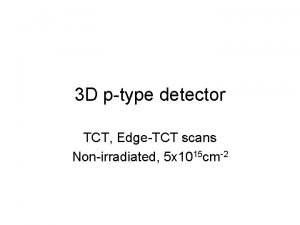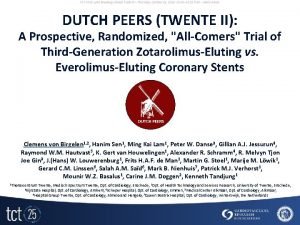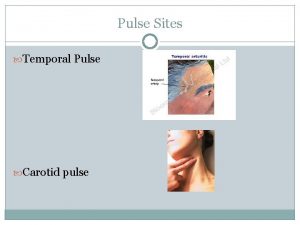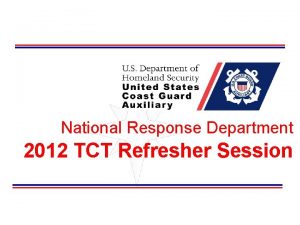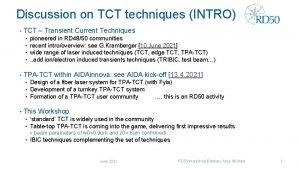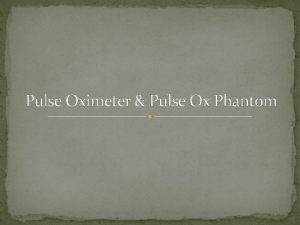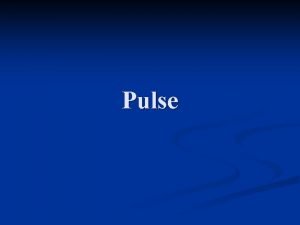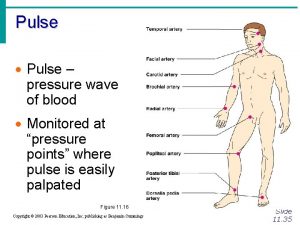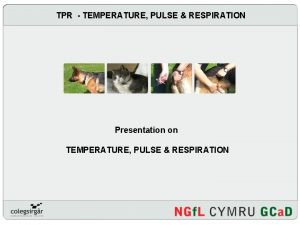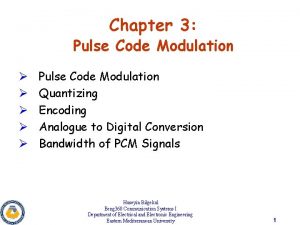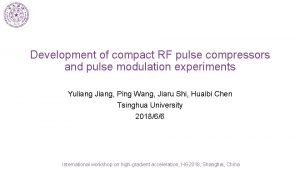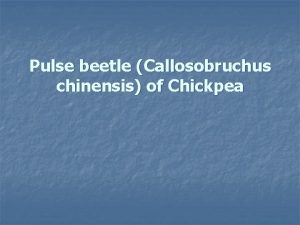Analysis of the pulse taken with TCT G







![Using the transfer function (I to Im) Time window for FT [0, 20 ns] Using the transfer function (I to Im) Time window for FT [0, 20 ns]](https://slidetodoc.com/presentation_image/1f0f3b089d5bd92f3a8309235cd12763/image-8.jpg)



![Reflection correction te ts Imax Bias-T/amp sample negative Iref, max positive L in [ns] Reflection correction te ts Imax Bias-T/amp sample negative Iref, max positive L in [ns]](https://slidetodoc.com/presentation_image/1f0f3b089d5bd92f3a8309235cd12763/image-12.jpg)




- Slides: 16

Analysis of the pulse taken with TCT G. Kramberger Jožef Stefan Institute G. Kramberger, Analysis of the pulse taken with TCT, 2 nd TCT Workshop 17/10/2016 1

What do we measure? � Three main factors contribute to the shape of measured signals T(t) I(t) P(t) ◦ induced current by movement of the carriers in the sensor – basically what we want to measure ◦ shape/duration of the laser pulse ◦ electronic transfer function of the system (including imperfections such as reflections) Im(t) The goals are: q In measurements get from Im to I q In simulations get from I to Im measured 17/10/2016 2 induced current Laser pulse transfer function G. Kramberger, Analysis of the pulse taken with TCT, 2 nd TCT Workshop

What do we want? Ideally we want to have: Ø Infinitely fast laser: Ø Infinitely fast response function: In this case the measured pulse Im would be the induced current I. However the word is not ideal and P and T have finite shapes. � One should always compare the width of the induced current with the durations of the laser pulse and electronic transfer functions (see M. Mikuž talk) – if T and P dominate it will be difficult to extract I. Saturation velocity of electrons 100 mm/ns and 80 mm/ns at 300 o. C ü 50 mm thick detectors -> pulse duration ~500 ps ü 300 mm thick detectors -> pulse duration ~3 -4 ns � T response is in the first approximation determined by the capacitance and input impedance of the electronics circuitry RC response 10 p. F, 50 W 17/10/2016 3 (note that most amps have rise time of 100 ps) G. Kramberger, Analysis of the pulse taken with TCT, 2 nd TCT Workshop

Example of measurements - standard FZ p-n diode, 5 x 5 mm 2, 300 mm, Vfd~20 V , Vbias=50 V KDet. Sim simulation § § Scanning-TCT measurment For relatively long signals a good agreement is observed for both measured and simulated current already without any analysis! The main differences: § Infinite rise/fall times in induced current are of course not measured § some pickup in signal before the trigger § reflections and other disturbances in the signal 17/10/2016 4 G. Kramberger, Analysis of the pulse taken with TCT, 2 nd TCT Workshop

Example of measurements – thin n-p diode on SOI wafer, 3 x 3 mm 2, ~45 mm, Vfd~20 V , Vbias=300 V rise time ~1. 5 ns KDet. Sim simulation TCT measurement Extreme case in terms of difficulties: � FWHM of laser ~1 ns – old laser driver � Much larger capacitance (20 p. F), hence RC and consequently rise time � Very fast signal at 300 V (almost saturation velocity 80 mm/ns) � Very thin detector 17/10/2016 5 Clearly the measured and simulated pulses are not the similar. G. Kramberger, Analysis of the pulse taken with TCT, 2 nd TCT Workshop

How to get to induced current? induced current measured Laser pulse and transfer function � But, how do we know PT ? ◦ Direct measurement –> a sensor of right capacitance where a I(t) would be very short, e. g. 25 mm thick detector◦ Use simulation on known device to extract the PT (see previous slide) C. Scharf and R. Klanner NIMA 779 (2015) p. 1 -5. 17/10/2016 6 G. Kramberger, Analysis of the pulse taken with TCT, 2 nd TCT Workshop

Use the simulation to get Transfer function Im I 100 V PT measured simulated higher harmonics � � A transfer function has a rise time (10%-90%) of 700 ps ~ which is comparable with RC Similar fall time with some undershoot What is the correct time window in which the FT is performed for the measurements? 17/10/2016 7 G. Kramberger, Analysis of the pulse taken with TCT, 2 nd TCT Workshop
![Using the transfer function I to Im Time window for FT 0 20 ns Using the transfer function (I to Im) Time window for FT [0, 20 ns]](https://slidetodoc.com/presentation_image/1f0f3b089d5bd92f3a8309235cd12763/image-8.jpg)
Using the transfer function (I to Im) Time window for FT [0, 20 ns] 50 V 70 V 90 V 110 V 130 V 150 V Time window for FT [0, 60 ns] Solid = simulated with transfer function Dashed = measured 50 V 70 V 90 V 110 V 130 V 150 V Solid = simulated with transfer function Dashed = measured With larger time window used in FT one includes the irregularities such as reflections into account, but inclusion of lower frequencies can result in more noise. An optimum has to be searched for each case individually. 17/10/2016 8 G. Kramberger, Analysis of the pulse taken with TCT, 2 nd TCT Workshop

Using the transfer function (Im to I) Signals are obtained from reverse FT. Time window for FT [0, 20 ns] Time window for FT [0, 60 ns] Lots of high frequency “grass” in the signal, except for the one used to determine the transfer function, which reproduces ideally the simulated signal. However, the slopes and duration of the signal corresponds well to the simulated results. Slightly smaller oscillations for smaller time windows. 17/10/2016 9 G. Kramberger, Analysis of the pulse taken with TCT, 2 nd TCT Workshop

Thin sensors Im to I and I to Im (worst case scenario) 300 V Significantly longer transfer function – higher capacitance and wider laser result in width exceeding the width of the induced current few times -> make sure that for thin sensors fast laser and small samples are used � Nevertheless approximately the shape of simulated and measured currents agree –note the transfer function was extracted at 300 V I to Im 20 V 70 V 120 V 170 V 220 V 270 V Im to I 50 V 100 V 150 V 200 V 250 V Pulse durations at low voltage are too short! 17/10/2016 10 G. Kramberger, Analysis of the pulse taken with TCT, 2 nd TCT Workshop

Thin sensors – using the transfer function on irradiated sensor Same sensor type irradiated to 1 e 16 cm-2 and annealed for 80 min@60 o. C. Transfer function as extracted from non-irradiated sample was used! measured Im to I 50 V 100 V 150 V 200 V 250 V � � � 17/10/2016 11 Clearly some features of the signal can be resolved even if measured signals are very similar. However, it is hard/impossible to conclude what e. g. trapping/velocity is. . . A time window of new ns works best – keeping only the frequencies that matter and forget the lower ones. G. Kramberger, Analysis of the pulse taken with TCT, 2 nd TCT Workshop
![Reflection correction te ts Imax BiasTamp sample negative Iref max positive L in ns Reflection correction te ts Imax Bias-T/amp sample negative Iref, max positive L in [ns]](https://slidetodoc.com/presentation_image/1f0f3b089d5bd92f3a8309235cd12763/image-12.jpg)
Reflection correction te ts Imax Bias-T/amp sample negative Iref, max positive L in [ns] Cref=Iref, max/Imax � � � For not perfect matching in impedance (for different reasons) reflections can occur in the signal at times larger than 2 L If L is sufficiently large most of the reflections are pushed outside “time interval of interest” e. g. 25 ns for L~12 ns cable If signals need to be observed on the time scale longer than that the transfer function doesn’t really matter (remember PT~1 ns) and reflections can be corrected offline in time domain 17/10/2016 12 usually n=2 is already enough! G. Kramberger, Analysis of the pulse taken with TCT, 2 nd TCT Workshop

Reflection correction Measured signals � � Corrected signals for reflection Chosen parameters: Cref=-0. 12, ts=0 ns , te=26 ns Note, with correction one avoids mistakes such as wrong determination of full depletion voltage. Without correction one might be tempted to attribute the kink in signal at around te as indication of full depletion voltage (nonexponential decrease of induced current). 17/10/2016 13 G. Kramberger, Analysis of the pulse taken with TCT, 2 nd TCT Workshop

Correction of baseline oscillations Small “Pickup“ can appear in the baseline – present for waveforms. Taken without laser beam Taken with laser beam in sensitive area HVCMOS Chess-1 chip baseline no baseline subtraction Baseline subtracted PSTCT meas; meas. Sub. His. Copy=1; meas. Set. Sub. Ref. WF(meas->Get. HA(0, 0)); 17/10/2016 14 G. Kramberger, Analysis of the pulse taken with TCT, 2 nd TCT Workshop

Software implementations � Both deconvolution of the signal as well as reflection correction are included in TCTAnalyse (latest version 1. 2 as from tomorrow) ◦ ◦ � TCTConv has three main methods : ◦ ◦ � TCTConv – deals with convolution (examples are included) TCTRefl – deals with reflection void Get. Transfer. Funtion(TH 1 F *measured, TH 1 F *simulated, Int_t Time. Low, Int_t Time. Hi); void Get. Ind. Cur(TH 1 F *measured, Time. Low, Int_t Time. Hi); TGraph *Convolute(TH 1 F *simulated, Bool_t mode); One has to pay attention to the units of both histograms! TCTRefl is always accounted during reading the measurements ◦ ◦ With default parameters Cref=0 nothing changes and one gets measured waveforms So simply put and the reflections will be corrected during reading � stct. Ref. C=-0. 12; � stct. Ref. Ts=0; � stct. Ref. Te=26; 17/10/2016 15 G. Kramberger, Analysis of the pulse taken with TCT, 2 nd TCT Workshop

Conclusions � � � There are two classes in the TCTAnalyse library that deal with signal processing ◦ TCTConv for taking transfer function into account ◦ TCTRefl for taking reflections occurring at longer times into account Significant improvement on understanding of your measurements can be achieved when signals are properly analyzed – so use them … However look at analyzed results with caution. 17/10/2016 16 G. Kramberger, Analysis of the pulse taken with TCT, 2 nd TCT Workshop
 Tct congress
Tct congress Tct scan
Tct scan Tct
Tct Tct 2013
Tct 2013 Where is the apical pulse located
Where is the apical pulse located Where is apical pulse
Where is apical pulse Hình ảnh bộ gõ cơ thể búng tay
Hình ảnh bộ gõ cơ thể búng tay Ng-html
Ng-html Bổ thể
Bổ thể Tỉ lệ cơ thể trẻ em
Tỉ lệ cơ thể trẻ em Gấu đi như thế nào
Gấu đi như thế nào Tư thế worm breton
Tư thế worm breton Alleluia hat len nguoi oi
Alleluia hat len nguoi oi Kể tên các môn thể thao
Kể tên các môn thể thao Thế nào là hệ số cao nhất
Thế nào là hệ số cao nhất Các châu lục và đại dương trên thế giới
Các châu lục và đại dương trên thế giới Công của trọng lực
Công của trọng lực

